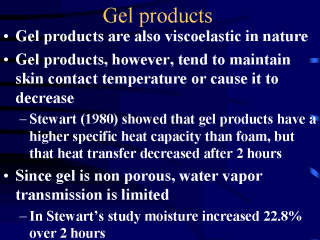 |
Solid gel
products respond similarly to viscoelastic foam products and are included in the category. Mean
temperature increases of 2.8 degrees C have been reported for viscoelastic foam . Gel
products tend to maintain a constant skin contact temperature or may decrease the contact
temperature. Gel pads have higher heat flux than foam due to the high specific heat of the
gel material. However, in Stewart's study the heat transfer decreased after 2 hours
indicating that the heat reservoir was filling. This suggests that the temperature may
increase during longer periods of unrelieved sitting (>2 hours). Stewart
also found that moisture increased 22.8% over a one-hour period. The relative humidity of
the skin surface increases considerably because of the nonporous nature of the gel pads. |
